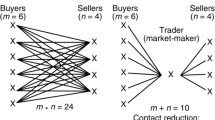Abstract
The electronic market hypothesis predicts that by reducing coordination costs, information technology (IT) will shift industrial organization from hierarchical to market-based forms of economic activity. While academic researchers and practitioners have witnessed these shifts with the advent of the Internet, there is little understanding about the process and the underlying forces that drive them. In this paper, we provide an in-depth analysis of the air travel industry, which has recently experienced significant IT-driven transformations. We conclude that, together with IT, pro-competitive laws and the information-intensive nature of air travel products have triggered competition for consumers with transparent market mechanisms, which is leading to the emergence of more transparent electronic markets in the air travel industry.







Similar content being viewed by others
References
Anandalingam G, Day RW, Raghavan S (2005) The landscape of electronic market design. Manage Sci 51(3):316–327
Bakos JY, Brynjolfsson E (1993) IT, incentives, and the optimal number of suppliers. J Manage Inf Syst 10(2):37–53
Campbell C, Gautam R, Muhanna WA (2005) Search and collusion in electronic markets. Manage Sci 51(3):497–507
Chircu AM, Kauffman RJ (2000) Reintermediation strategies in business-to-business electronic commerce. Int J Electron Commerce 4(4):7–42
Chircu AM, Kauffman RJ, Keskey D (2001) Maximizing the value of corporate travel reservation systems. Commun ACM 44(1):57–63
Christie WG, Schultz PH (1995) Did NASDAQ market makers implicitly collude? J Econ Perspect 9(3):199–208
Clemons EK, Reddi SP, Row MC (1993) The impact of IT on the organization of economic activity: the ‘move to the middle’ hypothesis. J Manage Inf Syst 10(2):9–35
Copeland DG, McKenney JL (1988) Airline reservation systems: lessons from history. MIS Q 12(3):353–370
Duliba K, Kauffman RJ, Lucas HC Jr (2001) Appropriation and value of airline computer reservation systems. Organ Sci 12(6):702–728
Global Aviation Associates (2001) The history and outlook for travel distribution in the PC-based Internet environment. Available at www.intervistas.com/4/presentations.asp. Accessed April 15, 2006
Granados NF, Kauffman RJ (2003) Can you see what I see? Transparency, consumer demand, and strategic pricing in B2C electronic commerce. In: Bharadwaj A, Narasimhan S, Santhanam R (eds) Proceedings of the INFORMS conference on IS and technology, Atlanta, October 2003
Granados NF, Kauffman RJ (2005) Identifying facilitators and inhibitors of market structure change: a hybrid theory of unbiased electronic markets. In: Sprague R (ed) Proceedings of the 38th Hawaii international conference in system sciences, Kona, January 2005. IEEE Computer Society Press, Los Alamitos
Granados NF, Gupta A, Kauffman RJ (2006) The impact of IT on market information and transparency: a unified theoretical framework. J Assoc Inf Syst 7(3):148–178
Grover V, Ramanlal P (1999) Six myths of information and markets: IT networks, electronic commerce, and the battle for consumer surplus. MIS Q 23(4):465–495
Hess CM, Kemerer CF (1994) Computerized loan origination systems: an industry case study of the electronic markets hypothesis. MIS Q 18(3):251–275
Hotwire (2002) Hotwire Q4 new users exceed priceline. Press release, Hotwire, San Francisco, February 4, 2002. Available at press.hotwire.com/index.php/press_releases/ pr2002/29.html. Accessed April 15, 2006
Jupiter Research (2004) Jupiter research forecasts the online travel industry will reach $91 billion by 2009, with supplier web sites increasing market share. Press release, Jupiter Media Corporation, Darien, November 10, 2004. Available at jupitermedia.com/ corporate/releases/04.11.10-newjupresearch.html. Accessed April 15, 2006
Kauffman RJ, Mohtadi H (2004) Proprietary and open systems adoption in e-procurement: a risk-augmented transactions cost perspective. J Manage Inf Syst 21(1):137–166
Klein S, Teubner RA (2000) Web-based procurement: new roles for intermediaries. Inf Syst Front 2(1):19–30
Madhavan A (2000) Market microstructure: a survey. J Financ Markets 3(3):205–258
Malone TW, Yates J, Benjamin RI (1987) Electronic markets and electronic hierarchies. Commun ACM 30(6):484–497
Mead KM (2002) OIG comments on DOT study of air travel services. Memorandum CC-2002–061, Office of the Secretary, from K. M. Mead, Inspector General, U.S. Department of Transportation, Washington, DC, December 13, 2002
Morgan Stanley Dean Witter (2000) The B2B Internet report: collaborative commerce. Equity Research, Morgan Stanley Dean Witter, New York
Morrison SA, Winston C (1996) Causes and consequences of airline fare wars. Brookings papers on economic activity: microeconomics. Brookings Institution, Washington, pp 85–131
Nielsen Net Ratings (2001) Online travel industry captures $1.2 billion in January, Led by Travelocity, according to Nielsen Net Ratings and Harris Interactive. Press release, Nielsen Net Ratings, New York, March 20, 2001. Available at www.netratings.com/pr/pr_010320.pdf. Accessed April 15, 2006
O’Toole K (2003) IT trends survey 2003. Airline Business Magazine, August 2003, pp 40–52
Regan K (2001) Study: economic slowdown aids online travel. E-commerce times, April 23, 2001. Available at www.ecommercetimes.com/perl/story/9156.html. Accessed, April 15, 2006
Regan K (2002a) Orbitz to list fares offline. E-Commerce Times, May 17, 2002. Available at www.ecommercetimes.com/perl/story/17807.html. Accessed April 15, 2006
Regan K (2002b) Orbitz unveils direct reservation system. E-Commerce Times, August 19, 2002. Available at www.ecommercetimes.com/perl/story/19060.html. Accessed April 15, 2006
Salkever A (1999) Dogfight in cyberspace: the online travel biz heats up. Daily briefing, BusinessWeek Online, November 15, 1999. Available at www.businessweek.com/bwdaily/ dnflash/nov1999/nf91115a.html. Accessed April 15, 2006
Stigler GJ (1964) A theory of oligopoly. J Polit Econ 72(1):44–61
United States Census Bureau (2005) United States Department of Commerce News. February 24, 2005. Available at www.census.gov/mrts/www/data/pdf/04Q4.pdf. Accessed April 15, 2006
Acknowledgments
The authors would like to thank the anonymous reviewers and co-chairs of the 28th Hawaii International Conference on Systems Science in the B2B E-Commerce mini-track. We especially benefited from personal interactions and comments on the content of this work from Charles Steinfield, Fu-ren Lin, Lynne Markus, and Rolf Wigand. Rob Kauffman thanks Donna Sarppo and the MIS Research Center at the University of Minnesota for partial support. Nelson Granados acknowledges funding through a Graduate School Fellowship and thesis costs support from the University of Minnesota. Alok Gupta’s work is supported by National Science Foundation Grant #IIS-0092780, for which he kindly acknowledges funding. All errors of fact or interpretation are the sole responsibility of the authors.
Author information
Authors and Affiliations
Corresponding author
Appendix: Illustration of OTA market mechanisms
Appendix: Illustration of OTA market mechanisms
To illustrate the level of transparency associated with different OTAs and how it has changed, we include several screen shots of travel search results for Travelocity, Hotwire, and Priceline.com, one prior to the change and one after the change for each firm.
-
(A)
Travelocity
-
Travelocity’s Original Market Mechanism
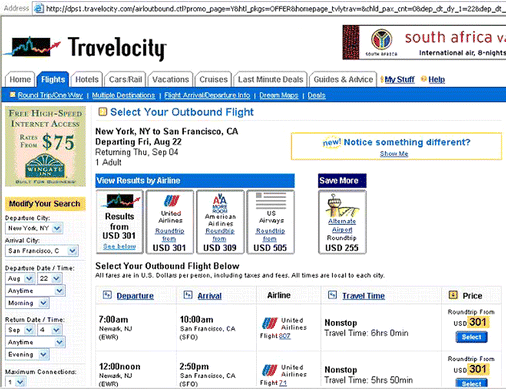
Source: www.travelocity.com, accessed in April 2004.
-
Travelocity’s Matrix Display
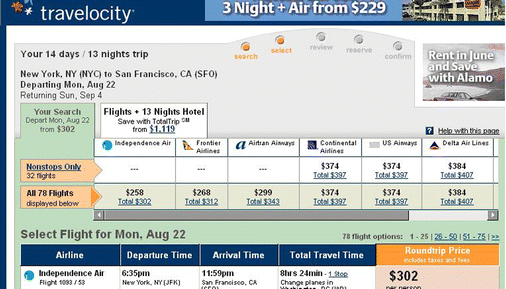
Source: www.travelocity.com, accessed in June 2005.
-
-
(B)
Hotwire’s Three-Tier Transparency Strategy
-
Hotwire’s Original Opaque Mechanism
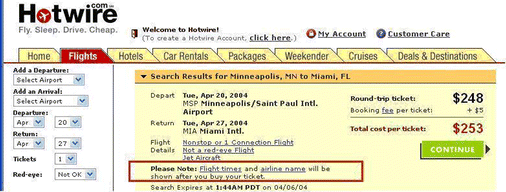
Source: www.hotwire.com, accessed in April 2004. In Hotwire’s original opaque mechanism, the airline name and itinerary are only shown after a purchase is made. Only a few travel options were provided.
-
Hotwire’s Semi-Opaque and Transparent Mechanisms
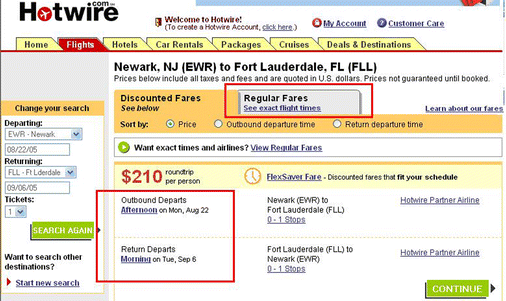
Source: www.hotwire.com, accessed in June 2005. In 2005, Hotwire added a semi-opaque mechanism, which provides a time frame for the itinerary but not an exact flight time nor the airline name. For offers with exact flight times and airline name, users have access to “retail fares.”
-
-
(C)
Priceline.com
-
Priceline.com’s Original “Name-Your-Own-Price” Mechanism
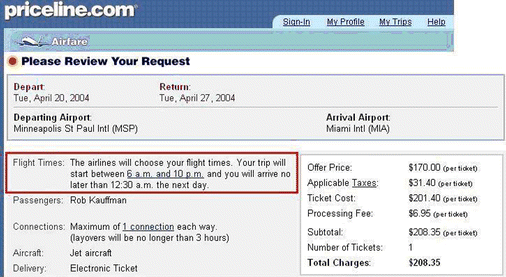
Source: www.priceline.com, accessed in April 2004.
-
Priceline.com’s Two-Tier Transparency Strategy: The Matrix Display
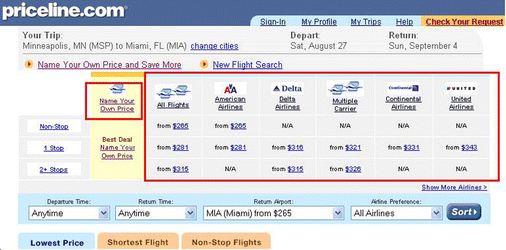
Source: www.priceline.com, accessed in June 2005. In addition to its opaque mechanism, Priceline.com now offers retail fares with a matrix display.
-
Rights and permissions
About this article
Cite this article
Granados, N.F., Gupta, A. & Kauffman, R.J. IT-enabled transparent electronic markets: the case of the air travel industry. ISeB 5, 65–91 (2007). https://doi.org/10.1007/s10257-006-0038-5
Published:
Issue Date:
DOI: https://doi.org/10.1007/s10257-006-0038-5


